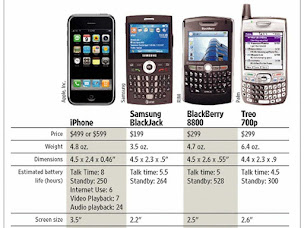Blog Post #6
The Creation of the iPhone
On January 9, 2007, Apple Inc. CEO Steve Jobs unveils the iPhone—a touchscreen mobile phone with an iPod, camera, and Web-browsing capabilities, along with many other groundbreaking features. Steve Jobs called the iPhone a “revolutionary and magical product that is literally five years ahead of any other mobile phone.” Six months later on June 29, thousands of customers were lined up at Apple Stores worldwide to purchase an iPhone.
The iPhone helped turn Apple into one of the most valuable corporations. In 2012, five years after the iPhone’s debut, more than 200 million had been sold. Today, iPhones and other Apple products are a part of everyday life for most. I myself own many Apple products. I own an iPhone, an Ipad, an Apple Watch, and what I am certain most of my classmate's use, a Macbook.

A Revelation
Take a look at why the iPhone was considered a "Revelation". On the left is a picture of the iPhone's competitors around the time of its release date. As you can see, the iPhone was a huge difference. The iPhone had a touch screen, longer talk time, Internet Use, Video Playback, and Audio Playback. One thing that stands out to me is the price of the first iPhone. The price ranged from $499 to $599. Now iPhones can cost more than $1,000!
The Design
The first iPhone technology was considered "state-of-the-art" at the time. John Casey and Jonathan Ive are the most credited designers for bringing CEO Steve Jobs' vision for a game-changing smartphone to life. The concept for the iPhone came about in 2000 when John Casey came up with the concept "Telipod". A Telipod was a telephone and iPod combination. The telipod never made it to production, however, Steve Jobs did like the idea of a cell phone with a touchscreen and high Internet access. Steve Jobs then sent engineers to get started on this idea.
Apple's first smartphone was the ROKR E1. This phone was a collaboration with Motorola, released on September 7, 2005. The ROKR was the first mobile phone that used iTunes, Apple's music software that debuted in 2001. Apple was not happy with the contributions that Motorola put forth. A year later, Apple discontinued support for the ROKR. This led to the announcement on January 9, 2007, at the Macworld Convention that, the iPhone would be coming into the world.
Jonathan Ive, Apple's chief design officer, was responsible for the sleek look and feel of the iPhone. Ive was also the main designer of the iMac, the titanium and aluminum PowerBook G4, Macbook, iPod, and iPad. The first iPhone was entirely touchscreen and had all of these new features that people have never seen before. The iPhone had no keypad for dialing, it had multitouch controls, and everything was controlled by a finger swipe. Along with those features, the very first iPhone introduced the accelerometer. The accelerometer is a motion sensor that allowed the phone to turn sideways and automatically display the rotation of the user's choice. The iPhone was not the first device to have applications or software add-ons, but it was the first smartphone to be successful at it.

What Is Next?
Since the debut of the first iPhone, Apple has released so many more phones and products. As new products are released, new and better features are released as well. Going forward, we do not know what Apple has in store for us, but I believe it will only get better and better!
 I believe the video about the famous display called FUTURAMA was an optimistic video. The visuals and the music were very optimistic. The narrator talked highly about new technology. The narrator made technology made it seem like it was the best thing going for the world. He mentioned that technology would make public transportation more convenient, it would provide ample space, and radiate shopping areas. He concluded by saying "there is a new beauty and new strength in the city of tomorrow. technology can point the way to a future of limitless promise...". The second video of the remix by Moby of the song by the group Tears For Fears was immediately pessimistic. You could tell by the tone of the video. The video showed people on their phone all the time, people recording fights rather than stepping in and trying to help, at the dinner table on their phone, etc. There was so much going on in the world and nobody realized what was happening because they were so attached to their phones.
I believe the video about the famous display called FUTURAMA was an optimistic video. The visuals and the music were very optimistic. The narrator talked highly about new technology. The narrator made technology made it seem like it was the best thing going for the world. He mentioned that technology would make public transportation more convenient, it would provide ample space, and radiate shopping areas. He concluded by saying "there is a new beauty and new strength in the city of tomorrow. technology can point the way to a future of limitless promise...". The second video of the remix by Moby of the song by the group Tears For Fears was immediately pessimistic. You could tell by the tone of the video. The video showed people on their phone all the time, people recording fights rather than stepping in and trying to help, at the dinner table on their phone, etc. There was so much going on in the world and nobody realized what was happening because they were so attached to their phones. 










